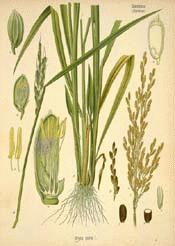

|
Rice
(Oryza sativa LINN.)
|
Rice
Botanical: Oryza sativa (LINN.)
Family: N.O. Graminaceae
---Synonyms---Nivara. Dhan. O. montana. O. setegera. O. latifolia. Bras. Paddy.
---Part Used---The seeds.
---Habitat---East Indies. Most sub-tropical countries.
---Description---Rice is an annual plant with several jointed culms or stems from 2 to 10 feet long, the lower part floating in water or prostrate, with roots at the nodes, the rest erect. The panicle is terminal and diffuse, bowing when the seed is weighty. It is probably indigenous to China, and certainly to India, where the wild form grows by tanks, ditches and rivers. It was early introduced into East Africa and Syria, and later into America, where it already appears as a native plant. In Europe, rice was brought into the Mediterranean basin from Syria by the Arabs in the Middle Ages, but is now grown largely only in the plain of Lombardy, and a little in Spain. In England it has been cultivated merely as a curiosity, and may be seen in the hothouses of most botanic gardens, treated as a water plant. The Cingalese distinguish 160 kinds, while 50 or 60 are cultivated in India, not including the wild form, from which the grain is collected, though it is never cultivated. Most kinds require irrigation, but some need little water, or can be grown on ordinary, dry ground.
Oryza (the classical name of the grain), or the husked seeds, is called Bras by the Malays, and Paddy when it is enclosed in the husk. Carolina and Patna rice are the most esteemed in England and the United States. The grain of the first is round and flat, and boils soft for puddings; the latter has a long and narrow grain that keeps its shape well for curries, etc.
The flour procured from the seeds is called Oryzae Farina, or rice flour, commonly known as ground rice.
The granules of rice starch are the smallest of all known starch granules.
A kind of spirit called Arrack is sometimes distilled from the fermented infusion, but the name Arrack is usually applied to Palm wine or Toddy.
[Top]
---Medicinal Action and Uses---The chief consumption of rice is as a food substance,but it should never be forgotten that the large and continued consumption of the white, polished rices of commerce is likely to be injurious to the health. The nations of which rice is the staple diet eat it unhusked as a rule, when it is brownish and less attractive to the eye, but much more nutritious as well as cheaper. Having no laxative qualities, rice forms a light and digestible food for those in whom there is any tendency to diarrhoea or dysentery, but it contains less potash and vegetable acids than potatoes.
A decoction of rice, commonly called ricewater is recommended in the Pharmacopceia of India as an excellent demulcent, refrigerant drink in febrile and inflammatory diseases, and in dysuria and similar affections. It may be acidulated with lime-juice and sweetened with sugar. This may also be used as an enema in affections of the bowels.
A poultice of rice may be used as a substitute for one of linseed meal, and finelypowdered rice flour may be used, like that of wheat flour, for erysipelas, burns, scalds, etc.
Rice starch may be used medicinally and in other ways in place of wheat starch.
A few years ago the injurious habit of chewing the raw white grains was practised by fashionable women and girls to produce a white velvety complexion.
[Top]
Common Name Index
A MODERN HERBAL Home Page
Bear in mind "A Modern Herbal" was written with the conventional wisdom of the early 1900's. This should be taken into account as some of the information may now be considered inaccurate, or not in accordance with modern medicine.
© Copyright Protected 1995-2004 botanical.com

|

